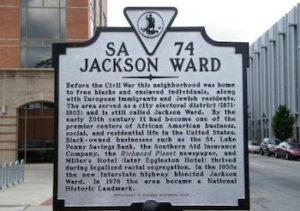
*Jackson Ward is celebrated on this date in 1871. This historically Black district in Richmond, Virginia, has a long tradition of Black businesses.
It is less than a mile from the Virginia State Capitol, sitting west of Court End and north of Broad Street. It was listed as a National Historic Landmark District in 1978. Often called “The Deuce,” Jackson Ward was originally the name of the area's political district within the city or ward until 1905. Yet, it has remained in use long after losing its original meaning.
The earliest houses of Jackson Ward were a series of small cottages built in the Federal style. By the later 1830s up until the Civil War, the Greek Revival style was prominent, representing a major part of Richmond's pre-war architectural heritage. And then, beginning in the 1850s, the Italianate styles. A major part of the district's visual appeal and charm derived from the contrast between the two ornamental and austere characteristics of the two styles. Early on, the neighborhood held a mix of German, Jewish, English, and African American residents. St Mary's German Catholic Church was built on Marshal St to serve the growing German Catholic immigrant community that had moved into the greater Richmond community from about 1850 to the 1880s.
After the American Civil War, previously free Blacks joined freed slaves and their descendants. The y created a thriving Black business community called the "Black Wall Street of America." Leaders included John Mitchell, Jr., editor of the Richmond Planet newspaper, and Maggie L. Walker. In 1903, she was the first woman to charter and serve as president of an American bank, an even more remarkable accomplishment as she was both black and mobility impaired.
As a center for black commerce and entertainment, Jackson Ward was called the "Harlem of the South." Venues along "The Deuce " (2nd Street), such as the Hippodrome Theater, were frequented by the likes of Duke Ellington, Ella Fitzgerald, Bill "Bojangles" Robinson, Lena Horne, Cab Calloway, Billie Holiday, Nat King Cole, James Brown, and other Chitlin' Circuit performers. Today, a statue of Robinson dancing on a staircase is at the center of the neighborhood at the intersection of Chamberlayne Parkway and West Leigh Street.
The center of the neighborhood is dominated by the former Armstrong High School, now the Richmond Public Schools Adult Career Development Center. Armstrong's sports field is now Abner Clay Park, with a bandstand, football field, basketball court, and tennis facilities. Notable historic churches in Jackson Ward include the Third Street Bethel African Methodist Episcopal Church, Hood Temple African Methodist Episcopal Church, Ebenezer Baptist Church, and Sixth Mount Zion Baptist Church. Sixth, Mount Zion is known as the home of Black evangelist John Jasper. Other notable residents included Bishop F. M. Whittle, Adolph Dill, Max Robinson, and his brother Randall Robinson.
The Leigh Street Armory is now being revitalized. It will be the future home of the Black History Museum and Cultural Center of Virginia, previously located at 00 Clay Street in Jackson Ward. Toward the end of the 20th century, Richmond worked to revitalize Jackson Ward, including its pre-existing housing stock. In the 1980s, historic tax credits by the federal government aided the restoration of dozens of houses on Leigh, Marshall, and Clay Streets. The Maggie L. Walker National Historic Site at her former Jackson Ward home is operated by the National Park Service. The house was designated a National Historic Site in 1978 and opened as a museum in 1985. City officials hoped constructing the Greater Richmond Convention Center and Visitors Bureau at the eastern edge of Jackson Ward would bring renewed vitality to the neighborhood. However, the convention center's construction destroyed several historic houses (including that used by the Hill, Tucker, and Marsh law firm) and separated Jackson Ward from much of downtown.
Richmond's Neighborhoods in Bloom program has targeted vacant and substandard houses in the neighborhood. Renovation has been slow in some areas, most notably with the First Virginia Volunteers Battalion Armory, best known as the Leigh Street Armory. In the mid-1980s, the Richmond School Board leased the armory building to the Black History Museum and Cultural Center of Virginia. The museum is expected to open in the armory in 2015. Many Richmond residents have bought houses in Jackson Ward to renovate and restore to live in a historic area and revive the cultural character of the neighborhood. First Fridays Art Walk is held at night on Broad Street each Friday of the month.
Art Galleries are open to outdoor parties with live music, including jazz and salsa. Local restaurants, bars, and coffee shops serve customers who come. On New Year's Eve 2014, the band Gwar opened GwarBar in Jackson Ward. The band described it as "a fantasy land of food and beverage, catering to everyone from local punk metal freaks, rock stars, businessmen, celebrity chefs, and starving artists."
Since the start of the 21st century, the neighborhood's reputation has rapidly changed from being a high-crime neighborhood to a popular historic district that rivals Fan and Church Hill. However, the neighborhood's revival has led to gentrification controversy, particularly since while in 2000 it still had a majority African American population, by 2010, nearly twice as many white people as Blacks lived in the neighborhood. Furthermore, the neighborhood's continued change focuses on developing mixed-use new construction and restoring existing historic buildings.